An exceptional human adventure
Published on November 20th, 2023
The biennial Mini Transat has been a proving ground for yacht design, as the 21-foot Mini Class has been the very first laboratory for sailing innovations. Canting keels, daggerboards, swinging wing masts, long poles for huge spinnakers, have been tried first on minis. New hull shapes with very wide waterlines and foils got traction there too.
The 24th edition, with racing in either the prototype or production (series) division, is done and dusted for the solo sailors that embarked on the two-stage course across the Atlantic Ocean. As in 2021, in order to meet ever-increasing demand, the number of participants for this 2023 edition was expanded from 84 to 90 (31 Proto and 59 Series).
Within this fleet, no fewer than 17 nationalities were represented (Argentina, Austria, Belgium, Brazil, Canada, Spain, United States, France, Great Britain, Italy, Japan, Luxembourg, Poland, Slovenia, Switzerland, Uruguay, Venezuela). Also noteworthy were the women (14) and the ‘repeat offenders’ (13). The average age? Thirty-three years, ranging from 21 to 66 years at the extremes.
In major offshore races like the Vendée Globe or the Route du Rhum, the abandonment rate generally hovers around 20%. In the Mini Transat, it typically fluctuates between 10 and 15%, but in 2023 generated only four abandonments: three in Proto and one in Series.
Those of Federico Sampei due to a dismasting, Matthieu Sapin due to energy problems, Alpha Eon Diakite after the loss of his keel, and Alexis Rochet due to steering and autopilot issues.
Since 1977, no fewer than 1,362 sailors (1160 solo) have lined up for the event, including 107 women. Arriving in last position in Guadeloupe after facing the breakage of a spreader shortly after leaving the Canary Islands, Belgian Romain Van Enis is, incredibly coincidentally, the 1000th sailor to have completed the course.
Another figure: no less than 38 countries have been represented, with France leading in terms of numbers, followed by Italy, Spain, Great Britain, Switzerland, and Belgium. Note: Venezuela was a newcomer this year.
Until now, six non-French sailors had succeeded in inscribing their names on the event’s record: American Norton Smith in 1979, Belgian Laurent Vancutsem in 1993, Swiss Yvan Bourgnon in 1995, Belgian Peter Laureyssens in 2005, Portuguese Francesco Lobato in 2009, and Italian Ambrogio Beccaria in 2019.
This year, Uruguayan Federico Waksman and Italian Luca Rosetti did the same, which was the first time in the history of the race that international skippers simultaneously won in both Proto and Series.
Taking advantage of perfectly established trade winds in the second stage, some solo sailors achieved supersonic averages aboard their Mini 6.50s. Hugues de Prémare literally made his boat smoke, breaking both the record for the greatest distance covered in 24 hours in a Series boat (291.47 miles set by Florian Quenot in 2019) and all categories combined (308 miles achieved by Pierre Le Roy in July 2022) with 317.25 miles covered between November 1st and 2nd, at an average speed of 13.22 knots. Félix Oberlé and Adrien Simon also exceeded the symbolic 300-mile mark in a Series boat. Their respective performances: 311 and 304 miles, respectively.
If the first stage (1,350 miles between Les Sables d’Olonne and Santa Cruz de La Palma) made an impression, the second (2,700 miles between Santa Cruz de La Palma and Saint-François) did even more so.
The first proved extremely complex, due to very changeable and uncertain weather. This resulted in a major turnaround in the last third of the course in favor of the west, and another at the very end of the course due to a formidable buffer effect on the Canary Island. As a result, monstrous gaps were created, and many favorites immediately took a hit, ruining, for some, their chances of performing well overall.
The second stage was very open, with the choice between two distinct options from the passage of El Hierro. North or south? That was the dilemma, with little or no difference between the two in the end, thanks to well-established trade winds for everyone from the fourth day of the race. In this context, speed clearly prevailed, and those who managed to maintain the pace both physically and mentally until the end reaped the rewards.
What will also be remembered? On the one hand, the 29 short minutes that Marie Gendron ultimately missed to become the fourth woman in the history of the race after Isabelle Autissier in 1987, Justine Mettraux in 2013, and Clarisse Crémer in 2017 to finish on the podium overall. On the other hand, the fifteen endless hours that Luca Rosetti had to wait to be assured of his victory in the Series boats.
An event like the Mini Transat generates emotions like excitement, enthusiasm, pride, disappointment, frustration, fear, nervousness, joy, euphoria, satisfaction, gratitude, admiration, solidarity, empathy, rivalry, and many more. The 90 sailors of this 24th edition were not exempt; boat choice, physical preparation, planning, logistics, budget, search for partners… All dedicated an average of two years to their project (up to eleven for some, like Marie Gendron).
In the end, although they certainly did not experience the adventure in the same way, they all finished with the same sense of accomplishment. It’s no small feat to overcome the challenge of crossing the Atlantic alone on a small 6.50-meter boat. ‘When you do the Mini Transat, there is a before and an after,’ summarized Aurélien Dhervilly.
Since its creation by Bob Salmon 46 years ago, the race has a magic of its own. It is rightly associated with moments of celebration, gathering, sharing, and joy. It combines elements such as atmosphere, emotions, memories, encounters, surprises, and unique experiences perfectly.
Also, the music, lights, colors, and smells. In Les Sables d’Olonne, Santa Cruz de La Palma, or Saint-François, the celebration was beautiful. Proof that if it is an exceptional human adventure… the Mini Transat is even much more than that!
Event information – Tracker – Facebook
After a one day postponement due to storms, the 24th edition of the Mini Transat, reserved for the Mini 6.50, the smallest offshore racing class at 21-feet, saw the first stage get underway on September 25, 2023.
Ninety solo sailors entered the 2023 Mini Transat with the competitors placed in divisions for prototype and production boats.
A notable proving ground for sailors with shorthanded aspirations, it is also test platform for new boat types, with competitors entering in the production division for manufactured boats and the prototype division for custom designs.
Held biennially, with limited participation for safety that includes strict qualification guidelines, the 4,050 nm course is divided in two parts with the combined elapsed time to determine the results:
September 25: Les Sables d’Olonne (France) to Santa Cruz de La Palma in the Canaries (Spain) – 1350 nm
October 28: Santa Cruz de La Palma in the Canaries (Spain) to Saint-François in Guadeloupe – 2700 nm
Source: Versace Sailing Management


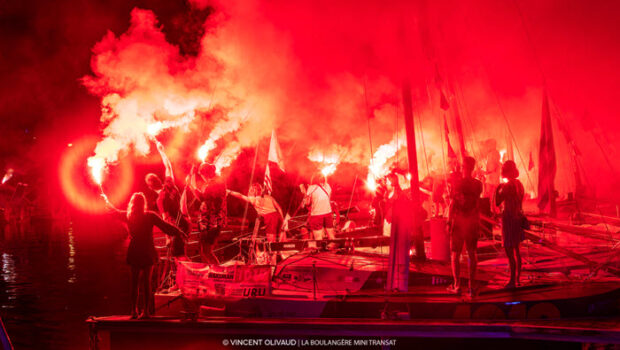

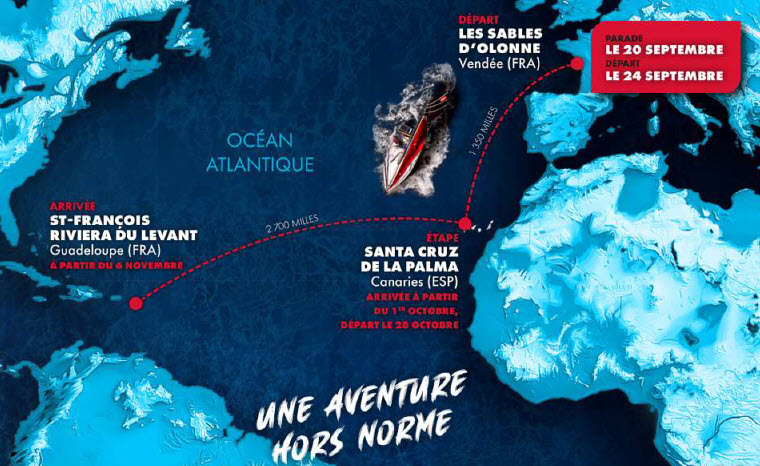


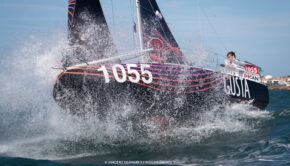
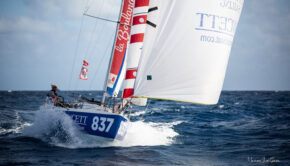
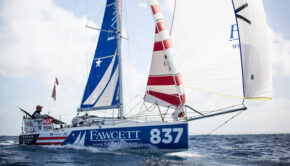
 We’ll keep your information safe.
We’ll keep your information safe.